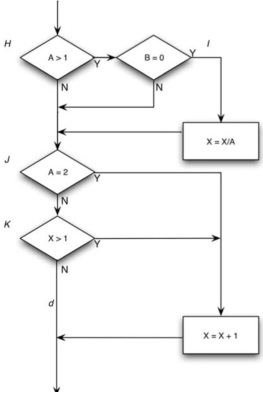Reference no: EM132847951
ITAP2008 Software Testing - Victorian Institute of Technology
1. Explain what is statement, decision and condition coverage.
2. Use following test cases and Identify the paths that could be tested in the program segment indicated in the Figure 1.
a. A1=2, B=0, X=4
b. A=2, B=1, X=1
c. A=1, B=0, X=2
d. A=1, B=1, X=1

Figure 1. Flowchart for a simple program with multiple conditions
3. Use following scenario and derive equivalence classes for testing. And create a table that shows test case number, test data, expected outcome and class covered.
Grocery Store
Consider a software module that is intended to accept the name of a grocery item and a list of the different sizes the item comes in, specified in ounces. The specifications state that the item name is to be alphabetic characters 2 to 15 characters in length. Each size may be a value in the range of 1 to 48, whole numbers only. The sizes are to be entered in ascending order (smaller sizes first). A maximum of five sizes may be entered for each item. The item name is to be entered first, followed by a comma, then followed by a list of sizes. A comma will be used to separate each size. Spaces (blanks) are to be ignored anywhere in the input.
4. Case Study - MTEST Multiple choice study program
MTEST is a program that grades multiple-choice examinations. The input is a data file named OCR, with multiple records that are 80 characters long. Per the file specification, the first record is a title used as a title on each output report. The next set of records
describes the correct answers on the exam. These records contain a ‘‘2'' as the last character in column 80. In the first record of this set, the number of questions is listed in columns 1-3 (a value of 1-999). Columns 10-59 contain the correct answers for questions 1-50 (any character is valid as an answer). Subsequent records contain, in columns 10-59, the correct answers for questions 51-100, 101-150, and so on.
The third set of records describes the answers of each student; each of these records contains a ‘‘3'' in column 80. For each student, the first record contains the student's name or number in columns 1- 9 (any characters); columns 10-59 contain the student's answers for questions 1-50. If the test has more than 50 questions, subsequent records for the student contain answers 51-100, 101-150, and so on, in columns 10-59. The maximum number of students is 200. The input data are illustrated in Figure 4.4. The four output records are:
1. A report, sorted by student identifier, showing each student's grade (percentage of
answers correct) and rank.
2. A similar report, but sorted by grade.
3. A report indicating the mean, median, and standard deviation of the grades.
4. A report, ordered by question number, showing the percent- age of students answering each question correctly.
Questions
1. Identify test cases
2. Identify boundary value cases related to the student's answers
3. Identify some error guessing test cases for the program.